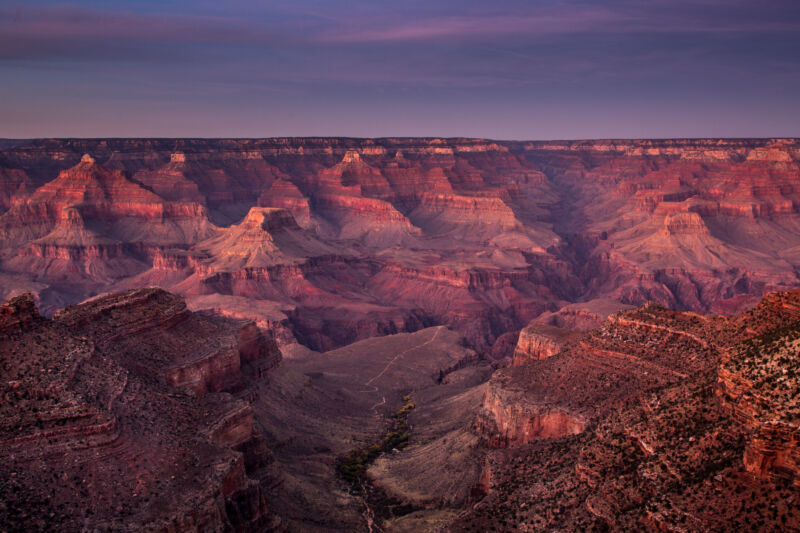
The explosive outbreak of gastroenteritis that erupted in the Grand Canyon earlier this year was likely sparked by multiple people hauling in norovirus infections, according to a recent study published by the Centers for Disease Control and Prevention in its Morbidity and Mortality Weekly Report. The infectious blast ended up violently hollowing out at least 222 visitors to the geologic marvel over a brisk but brutal three-month period
As Ars readers may recall, the National Park Service issued warnings early in the summer that an outbreak was gutting river rafters and hikers. But the new study, led by local and CDC officials, offers a more detailed look at the outbreak that left outdoor adventurers grasping the rims of basins much smaller than that of the Colorado River.The trouble appears to have begun in early April, with the first identified case striking a backpacker on April 4. On April 8, a commercial rafting company notified the National Park's Office of Public Health (OPH) that seven people on a rafting trip fell ill with vomiting and/or diarrhea. The cases kept streaming in through April and erupted in early May. The OPH contacted the CDC on May 11, after collecting dozens of case reports. By May 21, the OPH received reports of an additional 102 cases from 13 river rafting groups and several backpackers.
Local officials tested samples taken from portable toilets used by nine affected rafting groups. They found norovirus in all of them. Officials also tested toilet samples from two unaffected rafting groups, which were negative for norovirus. Of the nine positive samples, two were from rafting groups who visited the park in April, while the other seven were from May.
Genetic testing revealed that the strain of norovirus causing illnesses in April differed from the one found in May. Moreover, at least five people reported that their symptoms began more than 24 hours before their trip to the canyon. This all suggests a "potential for multisource introduction of norovirus into the river corridor," the authors wrote.
Bottoming out
To date, it's still unclear how the virus spread among the different groups and park visitors. But the authors note that "[b]ecause many trips use the same campsites and place portable toilets in the same locations, particles could have been transmitted to surfaces, beach sand, or river water where new groups could have encountered them, and then transmitted the virus both from person-to-person and trip-to-trip."
However the virus moved, it did so efficiently. The attack rate among rafting trip groups ranged from 10 percent (i.e., three rafters in a group of 31 fell ill) to a horrifying 83 percent (29 of 35).
In response to the cases, the OPH tried boosting sanitation around potable water spigots at campsites, including daily chlorine disinfections and mechanical devices that prevent backflow. They also raised awareness of the outbreak and advised visitors to wash their hands with soap and water, avoid sharing food, stay home if they're feeling ill, and immediately isolate anyone who falls ill. The authors highlighted that many people "were unaware that alcohol-based hand sanitizer is ineffective in mitigating norovirus transmission," and that washing with soap and water was the most effective prevention.
The efforts appeared to pay off. After alerts were posted in mid-May, the cases slowed to a trickle by the end of the month. Only three cases were reported in June, the last of which occurred on June 17. In all, the authors counted 222 cases between April 1 and June 17, 2022, but they say cases are "likely underreported."
Looking more broadly, the authors note that the outbreak at the Grand Canyon mirrors a nationwide surge in norovirus outbreaks during spring 2022. Like many infectious diseases, the highly contagious gut-busting virus died down amid the pandemic but came roaring back as pandemic health restrictions eased. A study published by the CDC last week found that norovirus outbreaks nearly tripled in the 2021-2022 surveillance year compared with the 2020-2021 surveillance year.
As such, park visitors should stay vigilant, the authors warn. "With norovirus increasing nationwide and visitation rates returning to near prepandemic levels, the potential exists for resurgence of norovirus outbreaks among visitors to the Grand Canyon backcountry," they conclude.
reader comments
91